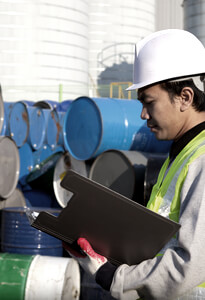OSHA Rules for Hazardous Chemicals
03
February,
2023
5 MINUTE READ

When dealing with hazardous chemicals, safety is key. However, the steps necessary to keep workers safe will vary, depending on the situation, and especially depending on the chemical in question. To address this, OSHA's rules for workplace safety include a variety of regulations addressing hazardous materials.
Some key regulations apply to nearly all workplaces and situations. For some specific chemicals and circumstances, OSHA applies additional requirements. These chemical regulations are found in OSHA's rules for general industry, in 29 CFR part 1910; specifically, in subpart H (Hazardous Materials, 1910.101 to 1910.126) and subpart Z (Toxic and Hazardous Substances, 1910.1000 to 1910.1450).
What is a Hazardous Chemical?
Some regulations, such as those from the Department of Transportation (DOT) or the Environmental Protection Agency (EPA), use strict or specific definitions to identify what counts as a "hazardous chemical." When discussing workplace safety and OSHA regulations, however, there are broader definitions. For these cases, a "hazardous chemical" is any chemical or mixture that presents a potential source of personal harm or property damage, as a result of its chemical properties.
Under OSHA's Hazard Communication Standard, or HazCom 2012, this is the technical definition provided: Hazardous chemical means any chemical which is classified as a physical hazard or a health hazard, a simple asphyxiant, combustible dust, pyrophoric gas, or hazard not otherwise classified.
-29 CFR 1910.1200(c)
In this definition, the terms "physical hazard" and "health hazard" cover the two main categories of chemical hazards derived from the Globally Harmonized System, or GHS. This system is an international standard for discussing issues of chemical safety, and OSHA has adapted it for use in the United States. Physical hazards include flammable materials, corrosive materials, and other physical dangers; health hazards include respiratory irritants, carcinogens, and other biological dangers.
The other types of hazards listed in the OSHA definition of "hazardous chemical" are discussed in detail later in the HazCom 2012 regulation. "Hazard not otherwise classified," or HNOC, is a catch-all category for hazards that haven't been described in the regulation, but are still recognized as hazards.
Key Chemical Safety Regulations
Some of the most important rules in subparts H and Z apply to a variety of industries, applications, and materials. Even when none of the other chemical regulations from OSHA apply, it's important to understand and follow these requirements.

- 1910.119 - Process safety management of highly hazardous chemicals. These rules apply to business processes where specific chemicals (from a list of over 100 materials) are present in specified quantities. This regulation specifically calls for a "process hazard analysis," which is similar to a Chemical Risk Assessment, but goes into more detail, and considers the kinds of failures or accidents that might make a work process more dangerous than normal. A process hazard analysis must be updated at least once every five years.
- 1910.120 - Hazardous waste operations and emergency response. These rules, also referred to as HAZWOPER, cover safety requirements for dealing with spills, leaks, and other unintended releases of hazardous chemicals, as well as dealing with hazardous wastes that are produced as part of an ordinary business process. Regulations from the EPA may also be relevant for these issues.
- 1910.1000 - Air contaminants. This regulation applies to a long list of materials that can be suspended or mixed into the air; the list includes identification of the specific chemicals that must be considered, along with the concentration of each chemical that will trigger the requirements in the rule. Some specific air contaminants, such as silica dust, have their own additional rules elsewhere.
- 1910.1020 - Employee exposure and medical records. Many chemicals have important health effects that result from repeated or long-term exposure. Scientific studies continue to find new effects caused by existing materials, as well. To provide a way to protect employees in the future, companies that deal with hazardous chemicals have an obligation to keep records of exposures, accidents, and medical tests.
- 1910.1030 - Bloodborne pathogens. While blood and other potentially infectious materials are not usually thought of as "chemicals," they are materials that can pose a distinct hazard to employee health. In addition to covering healthcare-related workplaces, these rules are important for any facility to deal with workplace injuries.
- 1910.1200 and 1201 - Hazard communication (HazCom 2012), and the rules for retaining DOT chemical labels (when they are already present). The Hazard Communication Standard (HCS), or HazCom 2012, consistently makes OSHA's top 10 list of frequently violated regulations. It requires chemical assessment, documentation including a Safety Data Sheet (SDS), container labeling, and employee training. These steps ensure that workers are aware of the chemical hazards that are present in their workplace. Duralabel explains key concepts of the regulation and provides advice on how to comply in a free Best Practice Guide to HazCom 2012.
- 1910.1450 - Hazardous chemicals rules for laboratory environments. Because laboratories often deal with huge varieties of materials in relatively small amounts, and because a given chemical may only be present for a short time, some of OSHA's regulations are relaxed slightly for laboratory applications. To maintain safety, this regulation describes the alternative protections that are needed.
General Rules for Groups of Materials
In addition to the key regulations that apply to many facilities, OSHA provides some rules covering general groups of materials.
- 1910.101 - Compressed Gases. This regulation provides general requirements that apply to most gases stored in pressurized tanks, referring to several industry standards produced by the Compressed Gas Associate (CGA). Additional rules, elsewhere in OSHA's regulations, apply for specific compressed gases.
- 1910.106 - Flammable Liquids. These rules apply to the production, use, and storage of all flammable liquids, importantly including motor vehicle fuels and other petroleum products.
- 1910.109 - Explosives and blasting agents. These rules cover the safe storage and use of explosive materials as part of a work process, but they also point to rules from the Department of Transportation (DOT) covering the safe transportation of these materials.
Rules for Specific Chemicals
Most of the individually numbered regulations in subparts H and Z address specific materials used in a variety of circumstances, or present in a variety of facilities. Where these chemicals are present, the matching rules must be followed, in addition to any general rules that apply.
- 1910.102 - Acetylene
- 1910.103 - Hydrogen
- 1910.104 - Oxygen
- 1910.105 - Nitrous Oxide
- 1910.110 - Liquefied petroleum gases (LPG), such as propane and butane
- 1910.111 - Anhydrous ammonia
- 1910.1001 - Asbestos
- 1910.1003 through 1016 - Special rules for a series of specific materials known to cause cancer. The affected chemicals are:
- 4-Nitrobiphenyl
- alpha-Naphthylamine
- methyl chromethyl ether
- 3,3'-Dichlorobenzidine and its salts
- bis-Chloromethyl ether
- beta-Naphthylamine
- Benzidine
- 4-Aminodiphenyl
- Ethyleneimene
- beta-Propiolactone
- 2-Acetylaminofluorene
- 4-Dimethylaminoazo-benzene
- N-Nitrosodimethylamine
- 1910.1017 - Vinyl chloride (chloroethene)
- 1910.1018 - Inorganic arsenic
- 1910.1024 - Beryllium
- 1910.1025 - Lead
- 1910.1026 - Chromium (VI)
- 1910.1027 - Cadmium
- 1910.1028 - Benzene
- 1910.1043 - Cotton dust
- 1910.1044 - 1,2-dibromo-3-chloropropane
- 1910.1045 - Acrylonitrile
- 1910.1047 - Ethylene oxide
- 1910.1048 - Formaldehyde
- 1910.1050 - Methylenedianiline
- 1910.1051 - 1,3-Butadiene
- 1910.1052 - Methylene Chloride
- 1910.1053 - Respirable crystalline silica (silica dust)
- 1910.1096 - Ionizing radiation (rules for dangerously radioactive materials)
Application-Specific Rules
A few of OSHA's regulations in these subparts address specific business processes, rather than specific chemicals.
- 1910.107 - Spray finishing using flammable and combustible materials
- 1910.123 to 126 - Special rules for dipping and coating operations
- 1910.1029 - Coke oven emissions
Preparing for Chemical Safety
The fundamental goal of each of these workplace chemical regulations is safety. Employers have an obligation to provide a safe workplace, and these detailed rules provide a framework for achieving that goal when dealing with chemical hazards.
Knowing the rules that apply to a workplace is the first step in complying with those rules and improving safety. From this point, a facility can use the Chemical Risk Assessment process to identify, evaluate, and control the risks associated with chemical hazards.
Many of the controls meant to protect workers will involve visual communication, such as container labels, storage area signs, and instructional labeling. A convenient and efficient way to create these visuals on site and on demand is with the DuraLabel line of industrial label and sign printers. Specialized printing supplies are available to match challenging environments, such as cold storage, oily surfaces, and long-term weather exposure.
Identify Chemical Risks Today
If you're ready to increase the safety of your facility, download our free Chemical Risk Assessment Guide to conduct your own risk assessment at your workplace. Get your copy below
RELATED RESOURCES

Permissible Exposure Limit
The OSHA Permissible Exposure Limit (PEL) establishes the upper limit for employee exposure to chemicals or ...
Read
What is OSHA Compliance?
Dangerous working conditions nationwide sparked the creation of the Occupational Safety and Health Act (OSH ...
Read
Occupational Exposure
The term "occupational exposure" refers to a potentially harmful exposure to hazards chemicals in the ...
Read.png)


